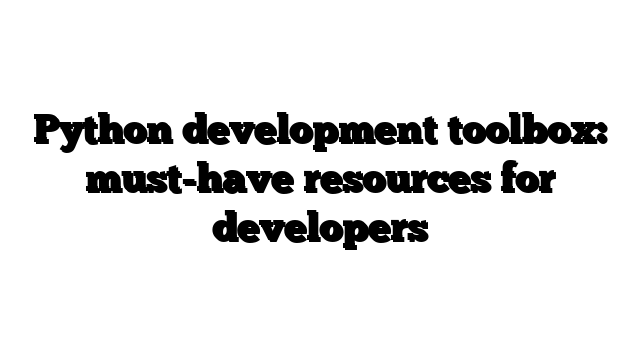Python has quickly risen to the ranks of the world’s most widely used programming languages. Due to its abundance of useful libraries and frameworks, as well as its relative ease of use.
Python has become one of the most popular programming languages, with a wide variety of use cases. Having the proper tools can greatly improve your efficiency and production, regardless of your level of experience as a developer. If you’re starting a new project or increasing your team, you need to hire dedicated Python developers and the necessary tools.
Every Python developer needs the tools we’ll be discussing in this article, so let’s take a look at a complete Python development toolkit.
- PyCharm IDE
When it comes to Python tools, PyCharm is a top pick. Being an integrated development environment (IDE), it offers a number of useful features, such as a smart code editor, navigation, auto-completion, a strong debugger, and a GUI-based test runner.
In addition, it helps with testing, does code inspections, and provides intelligent automatic code restructuring. Along with developer tools for profiling and debugging, the IDE includes a couple databases that are already installed.
Plus, Visual Studio is a great companion to all of this. Not only that, but it also works well with many other contemporary technologies, including JavaScript, TypeScript, HTML, CSS, and CoffeeScript. Integrating NumPy and Matplotlib allows one to expand its scientific computation capabilities.
For Python 3, PyCharm is compatible with versions 3.6 through 3.11. It also works with Python 2, version 2.7. When you hire Dedicated Python developers specialised with PyCharm Ide they bring a wealth of expertise and specialization in Python development.
- Jupyter Notebook
One well-liked open-source web program is Jupyter Notebook. The name is derived from the fact that it is compatible with R, Python, and Julia, three programming languages.
This tool has several uses, including but not limited to: creating visualizations, sharing documents with live code, and supporting interactive development. Additionally, it allows you to write notes alongside your programs and uses a console-based technique for document editing.
This tool is the go-to for data scientists and ML engineers when dealing with complicated assignments. Reason being, with Jupyter, you can test your code with the execution of a single cell, rather than running the full program. This makes code generation and execution much easier.
- Keras
The Python ecosystem includes the deep learning API known as Keras. A deep neural network (DNN) and its associated back-end computations can be built with this tool.
This tool is designed to be user-friendly, modular, and expandable with ease. Python makes it compatible with different neural network frameworks, so you may use it on top of PlaidML, Microsoft Cognitive Toolkit, TensorFlow, or CNTK.
Additionally, its open-source nature encourages contributors to enhance it further, which in turn simplifies the building of neural networks. In addition, it generates informative and useful error messages to help you troubleshoot your code.
A primary motivation for developing the language was to facilitate the rapid deployment of deep learning models. Python versions 2.7 and 3.5 are supported at the moment.
- Pip Package
Once you’re comfortable with Python, you might be interested in learning more about data science, AI, or data analysis. If that’s the case, you might have to install a few extra packages.
One tool that can help with this is Pip. Because it is useful for installing any Python package, this package is well-known among Python developers.
From Python 2 and Python 3, the pip package manager has been included in the Python installers. Actually, pip can be installed on your system by default with Python 3 thanks to the installer. Pip is extremely comparable to other languages’ package managers, such as npm in JavaScript, gem in Ruby, and NuGet in the.NET platform.
- Vim
An improved version of the original Vi editor for UNIX systems, Vim is a text editor. You may simply personalize it with the many available extensions. If you get the hang of Vim, you’ll have no trouble using it to code in Python. It may take a little while to adjust to, though, if this is all new to you.
Among Vim’s many notable characteristics include its ability to visually distinguish between viewing and editing files, its advanced editing commands, syntax highlighting, graphical versions, and its compatibility with a vast system of plugins.
- Selenium
Among the top Python development tools, Selenium is also highly regarded. It is a Python tool for agile testing and an open-source automation platform for web applications.
This tool is great for creating test scripts in a variety of languages, including Java, C#, PHP, and many more. It runs tests on Windows, macOS, and Linux, among other operating systems, and supports numerous browsers.
The tool is also useful for testing web applications built using Python in both automated and manual ways, as well as across different browsers. Furthermore, it may be integrated with technologies such as JUnit and TestNG to handle test cases and reports. Importantly, you have the option to turn automated testing into manual function tests if necessary.
- Sublime Text
Python code can be easily created with the help of Sublime Text, a lightweight text editor. This program is quick and works with a wide variety of languages.
You can extend the editor’s functionality with plugins. Attractive features include a syntax definition engine and auto-completion that is very mindful of context. Plus, it has a wealth of documentation for the Python API, which is great for newcomers.
Among its other features are a command palette, project-specific options, broad customization, multi-tabbed selection, and fast access to lines, files, and symbols. Simultaneous editing is also possible.
Conclusion
For developers in the year 2024, these were among the top Python programming tools. You may enhance your efficiency and productivity in web development using these Python development tools, regardless of your level of experience. Hire dedicated Python developers to speed up code, make code cleaner, auto-complete code, download big data, and organize it for different purposes.
James Martin is a passionate writer and the founder of OnTimeMagazines & EastLifePro. He loves to write principally about technology trends. He loves to share his opinion on what’s happening in tech around the world.


